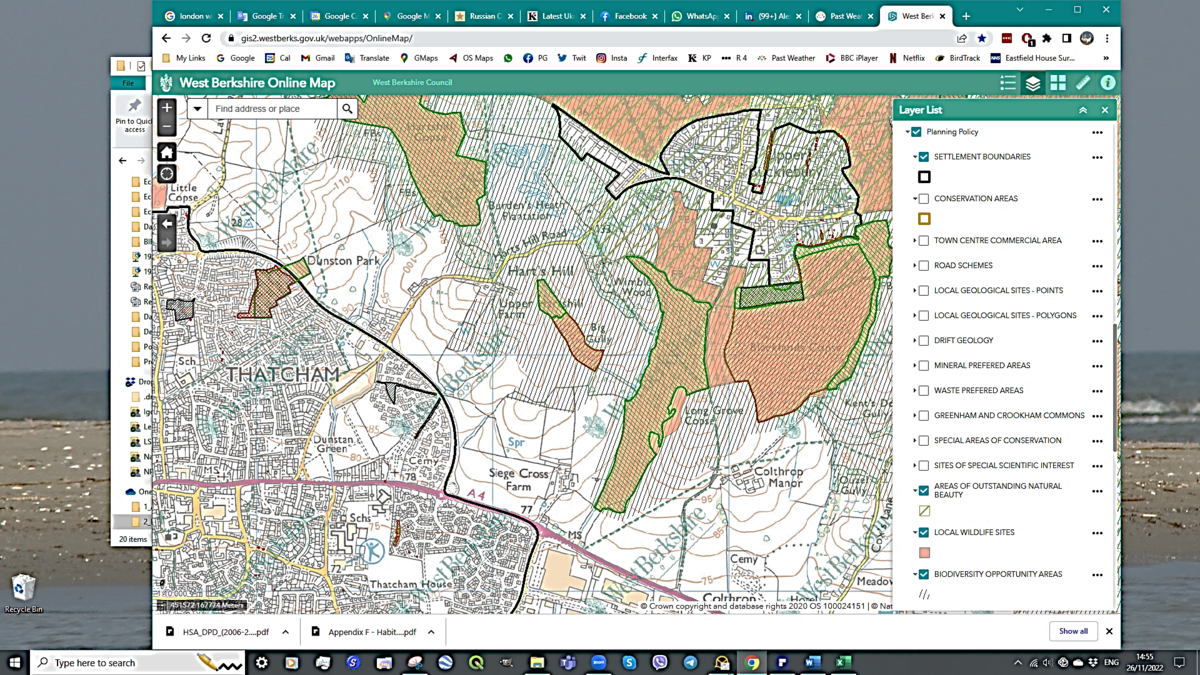Environment
West Berkshire Council (WBC) LPR Review: Regulation 19 Consultation
20th January – 3rd March, 2023
Specific Objections - No. 5: Environmental Issues
Bucklebury Says No has identified a number of serious environmental threats posed by the proposed Thatcham North-East strategic development site (SP17). These include:
- Collateral damage to the Bucklebury Plateau Biodiversity Opportunity Area (*see map at end) and its ancient woodlands and heaths, in particular the Common;
- Siting a major greenfield development in the broader landscape setting of the North Wessex Downs AONB that will forever impair enjoyment of the open countryside by local communities;
- Causing detrimental impacts to legally protected wildlife known to be present on the site but assuming that sufficient mitigation measures can be taken after development e.g. through the vague promise of a ‘community park’.
Taken together, and after a thorough professional review of the background documentation provided by WBC in support of the draft LPR, we have concluded that there is no evidence to support claims that SP17 will have a positive impact on the environment. By contrast, there is every reason to believe it will have a significantly negative impact.
For example, the WBC states in the LPR that a Sustainability Charter is required to establish how ‘policy requirements will be achieved’ (including the legally required biodiversity net gains and the anticipated overall positive impact on environmental sustainability). It maintains that the Charter ‘will be informed by’ various strategy documents (including one on ecology). Yet, the strategy documents either do not exist or have not been made publicly available for the Regulation 19 consultation.
We estimate that at least 4,000 people will be concentrated in the development site. They of course must have access to green space for recreation and general wellbeing. We do not believe that the claimed provisions for green space will satisfy this demand on site. The original Thatcham Growth Plan had a vague proposal for two ‘country parks’ spaced across the top of the slope, inside the Biodiversity Opportunity Area, claiming the potential for significant biodiversity enhancement over its current land use. No details were provided about how they would be formed. Our own feasibility study showed the complete lack of preparation for such country parks, not least that they should be merged, and properly managed and funded to deliver that stated biodiversity enhancement. Now, in the updated SP17 text, the country parks have been downgraded to undefined ‘community parks’ which only proves how little commitment WBC has given to protecting the natural environment and public enjoyment of it.
Since SP17 has no proven plans for providing adequate green space and protecting biodiversity, there will inevitably be spill-over of people visiting adjacent areas.
Indeed, the LPR states its intent for SP17 to drive additional traffic (people and cars) into the AONB. It provides a green infrastructure network which will ‘take advantage of the landscape’ to ‘facilitate connection to the AONB, and include leisure routes accessible to all users.’
Meanwhile, the management vision for Bucklebury Common is explicitly focused on not increasing human pressure on the fragile ecosystems they are working to restore and nurture.
In fact, the LPR’s own Sustainability Appraisal accepts that SP17 will have a negative impact on environmental sustainability: ‘The site is a greenfield site and therefore, would result in a negative impact on environmental sustainability which would need to be mitigated.’ But there is no detail whatsoever on any such mitigation measures: the assumption is simply that they will somehow be found during the planning application process.
However, the very same Sustainability Appraisal suggests that the SP17 policy is likely to have an overall positive impact on sustainability – largely by absurdly ignoring the environmental consequences in favour of social and economic benefits that are anyway highly questionable (see other articles herein).
The overall thrust of the SP17 policy is clearly to build as many houses as possible in a small area of countryside, while making empty promises about how the environment – human and natural – will be improved or, if not, mitigated. Despite all the money spent on consultants to prepare the housing plans and justify the ‘growth’ requirement, there is no evidence of any serious attempt to investigate, analyse and systematically address the consequences. Everything will be all right because their own unsubstantiated policies say it will be.

Map of the *Biodiversity Opportunity Area (green hatching), and ancient / protected woodlands (red hatching)